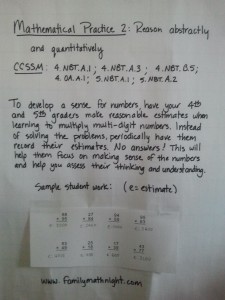Reason Abstractly and Quantitatively
Estimates help us predict the reasonableness of an answer. Having students make an estimate before they perform the calculation, and even writing the estimate next to the problem, can help them to focus on making the numbers (and the problem) make sense.
Example: 3.2 x 9.8 =
Students use benchmarks to determine that 3.2 is close to 3 and 9.8 is close to 10, therefore, a reasonable estimate would be 3 x 10 = 30.
If students perform the actual computation and get 313.6, they know they need to revisit their work.
Sometimes I have my students complete their practice problems by simply having them make estimates – no calculated answers allowed! It may take awhile for students to get used to this as they are so used to turning in answers. But it’s a simple and powerful way to build number sense in our students. It forces them to look at the numbers and understand the operations they are performing on them. And it allows you, the teacher, to assess their understanding. Over time, making sense of the reasonableness of their answers will become a part of their problem-solving routine.
